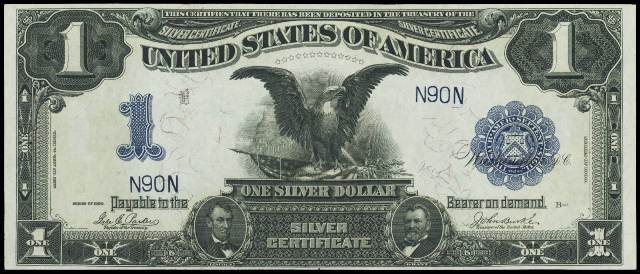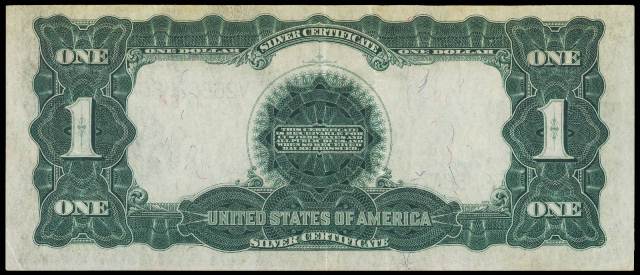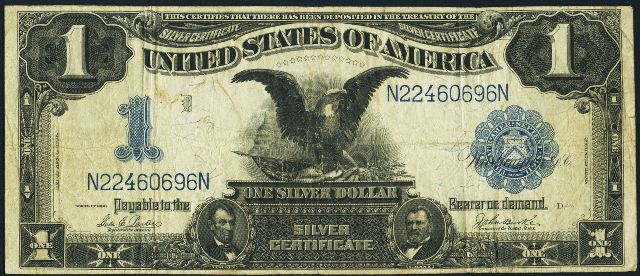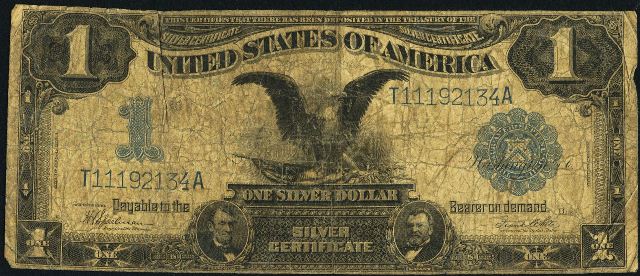Series of 1899 $1 Silver Certificate – Black Eagle
History: There is nothing especially noteworthy about the 1899 $1 silver certificate. The issue was printed for more than two decades. So just because every bill says series of 1899, that does not mean that it was actually printed in 1899. You really have to focus on the signature combination and block letters to learn when the bill left the printing presses. The 1899 $1 bill is very common. You can walk into just about any coin store or coin show and see plenty of them. A lot of this has to do with their printing numbers. Literally hundreds of millions were issued by The United States. Thousands are still known to exist.
Nickname: It doesn’t take much work to figure out the nickname of the 1899 $1 silver certificate. A quick glance shows three vignettes, an eagle, Ulysses S Grant, and Abraham Lincoln. Somewhere along the way the collecting world decided that this note should be called a “black eagle.” The name has stuck. Whether you have been collected for a week or your entire life, you certainly know what a black eagle is. Grant and Lincoln often get overlooked. That might be for the best since both men are closely associated with several other large size pieces of currency.
Other Facts: Black eagle 1899 $1 silver certificates are common. However, there are lots of ways to collect them. It is possible to get low serial numbers from all 12 signature combinations. For some reason it seems that 100s of low serial number and fancy serial number black eagle notes were saved. Obviously someone at the Bureau of Engraving and Printing appreciated serial number oddities. There are also a lot of what we call “courtesy autographs” available. A courtesy autograph means that the treasury official whose signature appears on the bank note, also hand signed the note. Even today you could mail a $1 bill to a treasury official and he or she might sign it for you. Back in the day you could do the same thing. Hundreds of courtesy autographed 1899 $1 bills are out there and held by collectors.
Values and Grading: The value of an 1899 $1 silver certificate is based on three major factors. The condition is most important. People pay more money as the grade gets higher. Signature combinations can add a premium. Some combinations are rare and were only issued for a very short period of time. Finally, some serial numbers can make certain notes worth more than others. A serial number under 100 is good, as are serial numbers that begin with a star symbol. A generic 1899 $1 bill in perfect condition is usually worth about $350. The same note with a fancy serial number might be worth $750. The same note (without a good serial number) with a rare signature combination could be $1,500. This is why you really need to work with an expert when trying to determine the value of any large size paper money. It is difficult to list all the variables that can affect values. However, a picture is worth 1,000 words.
Choice Uncirculated or Better: There are thousands of uncirculated 1899 $1 black eagles known to exist. We have even handled packs of 100 consecutive notes, all in perfect condition. High grade 1899 $1 bills have really come down in value since the peak of the market in 2008. Sadly, what was worth $800 then, might only sell for $450 today. However, today’s prices are still well ahead of what a black eagle in gem uncirculated condition was worth in the late 1990s, which was about $100. There are several different price points for an UNC note based on its serial number and signature combination. It is not possible to list them all here. We would strongly encourage you to contact us directly so we can look at what you have, check it for varieties, and get you an accurate value.

This Uncirculated 1899 $1 Bill Is Worth About $400
Extremely Fine to About Uncirculated: A grade of extremely fine 40 implies 3 folds. Extremely fine 45 usually has two folds. The AU grades between 50 and 58 can’t have more than one fold. There are thousands of 1899 $1 silver certificates available in these grades. Prices typically range between $150 and $250. This grade is all about paper quality. Collectors will pay a premium for 1899 $1 bills that are crispy and white. If the note has been pressed or washed in an attempt to remove the folds, then that note automatically becomes much less desirable. Keep in mind that anything that looks like a fold probably is a fold. When grading paper money you have to be as critical as the next person.

1899 $1 Silver Certificates In This Grade Are Worth around $125
Fine to Very Fine: The fine 12 to very fine 35 grade is typically known as a “collector grade.” That simply means that collectors looking for an example of the type can find something in this grade range with decent eye appeal for a cheap price. Most 1899 $1 silver certificates in fine or very fine condition sell for between $50 and $125. The high range would be reserved for an especially attractive VF 35. Notes should have strong paper, good color, and no damage.

This Black Eagle Note Would Retail For About $80 On A Good Day
Very Good and Lower: 1899 $1 silver certificates in this grade are what you will typically see at the local flea market, coin shop, or antique store. Expect to find damage, rust, stains, ink, tears, missing pieces, or other undesirable traits. Prices can be as little as $5 or as high as $30. Black eagles in this grade just aren’t attractive. For an extra $30 you can get a decent looking fine. Very few collectors have to settle for this grade. Even star notes and rare signature combinations aren’t popular in the grades of poor, fair, about good, and good. They just don’t have enough eye appeal for most collectors.

This Is A Fully Intact But Heavily Circulated 1899 $1 Bill. It Is Worth Around $30
Need an Appraisal or Offer? We buy most 1899 $1 silver certificates. We are specifically looking for high grade examples, star notes, and rare signature combinations. Most 1899 $1 bills are common. However, if you have something interesting, then you might be shocked at our offer. Send us an email with pictures and we will respond quickly with our best offer. Sales@AntiqueMoney.com


